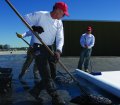
In both reroofing projects and new roof applications, TPO
roofing systems offer environmentally friendly options that help reduce energy
use.
With desire for eco-friendly commercial roofing products on the rise, it’s no wonder thermoplastic roofing systems have seen tremendous growth in the recent years. Contractors, architects and specifiers have all come to depend on thermoplastic roofing membranes because of their many benefits, including ease of installation, solar reflectivity, and outstanding performance on low-sloped or select steep-sloped substrates. The first thermoplastic roofing membranes, introduced in the early 1980s, raised concerns over issues of durability, fire resistance, weathering resistance, cold temperature flexibility and wind uplift performance.
These early thermoplastic membranes were typically non-reinforced and may not have been properly formulated to withstand the harsh environment seen in rooftop exposure. By the early 1990s, thermoplastic roofing membranes were being produced with reinforcing scrim and much improved formulations to reduce concerns raised by the previous generation.
Today, thermoplastics are typically reinforced with a scrim to provide dimensional stability and strength as well as improved formulations, which protect the membrane from the harsh rooftop environment. Thermoplastics are also now available in a variety of sheet sizes and thicknesses.

Today’s thermoplastics are typically reinforced with a woven
scrim to provide dimensional stability and strength. Thermoplastics are
available in a variety of sheet sizes and thicknesses.
System Types
There are two predominant thermoplastic roofing materials currently available: polyvinyl chloride (PVC) and thermoplastic olefin (TPO) systems.PVC membranes have a 20-plus year performance history of use in the United States and provide the longest record of any thermoplastic membrane currently on the market. PVC contains about 65 percent chlorine. PVC can release hydrogen chloride gas and carcinogens into the air if it is burned or disposed of incorrectly. Some manufacturers, including Firestone, have phased out PVC products in recent years in favor of TPO due to environmental concerns.
Within the thermoplastic category, TPO has become increasingly popular in low-slope commercial roofing system applications. TPO membranes are formulated to inhibit flammability, while increasing their resistance to UV radiation, chemical exposure and heat degradation. High-quality TPO membranes provide puncture resistance, durability and energy-saving properties. TPO systems can also be used in conjunction with vegetated and photovoltaic (PV) roofing systems, which increase energy efficiency, decrease energy costs and reduce urban heat-island effect. Compared to other thermoplastics, TPO membranes are usually offered in larger sheets that provide time-efficient installations, leading to lower labor costs for application of the roof system. Currently, manufacturers are starting to make TPO even easier to install by creating self-adhered membranes. With some cities having very strict air emissions codes, self-adhered TPO work well because they produce zero fumes and are VOC-free.

Thermoplastic roofing membranes offer many benefits,
including ease of installation, solar reflectivity, and outstanding performance
on low-sloped or select steep-sloped substrates. (Photos courtesy of Firestone
Building Products.)
Pre-Installation Considerations
Thermoplastic roofing membranes are typically installed using mechanical fasteners or are fully adhered to insulation, cover boards or the roof deck using adhesives. Due to the inherent nature of thermoplastic membranes, they are typically seamed by heat-welding with hot air. Heat welding a thermoplastic membrane provides monolithic seams without the use of primers, tapes or adhesives. This will typically result in reduced installation time.Consideration must also be given to the environment in which the roof system is to perform. Mechanically attached systems use stress plates with mechanical fasteners to attach the roof membrane to the deck. These stress plates are usually attached in the seam area. In areas with high wind uplift requirements, an enhanced welding system may be used to achieve higher code ratings. Dual or wide seams join the two sheets of membrane together on both sides of the fastening plates. This changes the dynamics of the force acting on the stress plate and fastener, enabling the system to achieve higher wind uplift performance.
Depending on what system is chosen, the condition of the substrate needs to be considered as well. For example, in a fully adhered application, underlayments must be free of dust and contaminates or the adhesive will not provide adequate adhesion. In addition, thermal insulation boards that are resistant to solvent fumes are needed if solvent-based adhesives are going to be used. Higher density substrates should also be considered for areas that are prone to events such as hailstorms.

In a fully adhered application, the substrate must be free
of dust and contaminants.